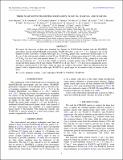Three WASP-south transiting exoplanets : WASP-74b, WASP-83b, and WASP-89b
View/
Date
07/2015Author
Funder
Grant ID
ST/M001296/1
ST/I000666/1
PP/D000890/1
ST/K001515/1
ST/J001651/1
ST/G001006/1
PP/F000065/1
Keywords
Metadata
Show full item recordAbstract
We report the discovery of three new transiting hot Jupiters by WASP-South together with the TRAPPIST photometer and the Euler/CORALIE spectrograph. WASP-74b orbits a star of V = 9.7, making it one of the brighter systems accessible to southern telescopes. It is a 0.95MJup planet with a moderately bloated radius of 1.5 RJup in a 2 day orbit around a slightly evolved F9 star. WASP-83b is a Saturn-mass planet at 0.3 with a radius of 1.0 RJup. It is in a 5 day orbit around a fainter (V = 12.9) G8 star. WASP-89b is a 6 MJup planet in a 3 day orbit with an eccentricity of e = 0.2. It is thus similar to massive, eccentric planets such as XO-3b and HAT-P-2b, except that those planets orbit F stars whereas WASP-89 is a K star. The V = 13.1 host star is magnetically active, showing a rotation period of 20.2 days, while star spots are visible in the transits. There are indications that the planet's orbit is aligned with the stellar spin. WASP-89 is a good target for an extensive study of transits of star spots.
Citation
Hellier , C , Anderson , D R , Collier Cameron , A , Delrez , L , Gillon , M , Jehin , E , Lendl , M , Maxted , P F L , Pepe , F , Pollacco , D , Queloz , D , Ségransan , D , Smalley , B , Smith , A M S , Southworth , J , Triaud , A H M J , Turner , O D , Udry , S & West , R G 2015 , ' Three WASP-south transiting exoplanets : WASP-74b, WASP-83b, and WASP-89b ' , Astronomical Journal , vol. 150 , no. 1 , 18 . https://doi.org/10.1088/0004-6256/150/1/18
Publication
Astronomical Journal
Status
Peer reviewed
ISSN
0004-6256Type
Journal article
Collections
Items in the St Andrews Research Repository are protected by copyright, with all rights reserved, unless otherwise indicated.
Related items
Showing items related by title, author, creator and subject.
-
A prospective new diagnostic technique for distinguishing eruptive and noneruptive active regions
Pagano, Paolo; Mackay, Duncan H.; Yardley, Stephanie L. (2019-09-26) - Journal articleActive regions are the source of the majority of magnetic flux rope ejections that become coronal mass ejections (CMEs). To identify in advance which active regions will produce an ejection is key for both space weather ... -
From dense hot Jupiter to low-density Neptune : the discovery of WASP-127b, WASP-136b, and WASP-138b
Lam, K. W. F.; Faedi, F.; Brown, D. J. A.; Anderson, D. R.; Delrez, L.; Gillon, M.; Hébrard, G.; Lendl, M.; Mancini, L.; Southworth, J.; Smalley, B.; Triaud, A. H. M.; Turner, O. D.; Hay, K. L.; Armstrong, D. J.; Barros, S. C. C.; Bonomo, A. S.; Bouchy, F.; Boumis, P.; Collier Cameron, A.; Doyle, A. P.; Hellier, C.; Henning, T.; Jehin, E.; King, G.; Kirk, J.; Louden, T.; Maxted, P. F. L.; McCormac, J. J.; Osborn, H. P.; Palle, E.; Pepe, F.; Pollacco, D.; Prieto-Arranz, J.; Queloz, D.; Rey, J.; Ségransan, D.; Udry, S.; Walker, S.; West, R. G.; Wheatley, P. J. (2017-03-01) - Journal articleWe report three newly discovered exoplanets from the SuperWASP survey. WASP-127b is a heavily inflated super-Neptune of mass 0.18 ± 0.02 MJ and radius 1.37 ± 0.04 RJ. This is one of the least massive planets discovered by ... -
The well-aligned orbit of Wasp-84b : evidence for disk migration of a hot Jupiter
Anderson, D. R.; Triaud, A. H. M. J.; Turner, O. D.; Brown, D. J. A.; Clark, B. J. M.; Smalley, B.; Cameron, A. Collier; Doyle, A. P.; Gillon, M.; Hellier, C.; Lovis, C.; Maxted, P. F. L.; Pollacco, D.; Queloz, D.; Smith, A. M. S. (2015-02-10) - Journal articleWe report the sky-projected orbital obliquity (spin–orbit angle) of WASP-84 b, a 0.69 planet in an 8.52 day orbit around a G9V/K0V star, to be λ = −0.3 ± 1.7°. We obtain a true obliquity of ψ = 17.3 ± 7.7° from a measurement ...

